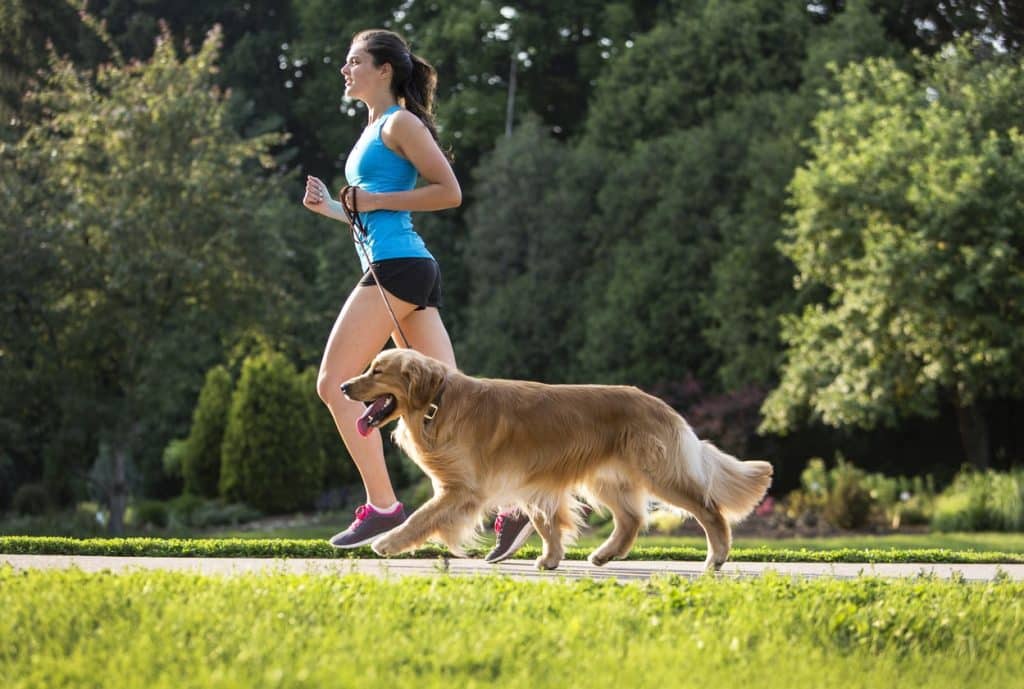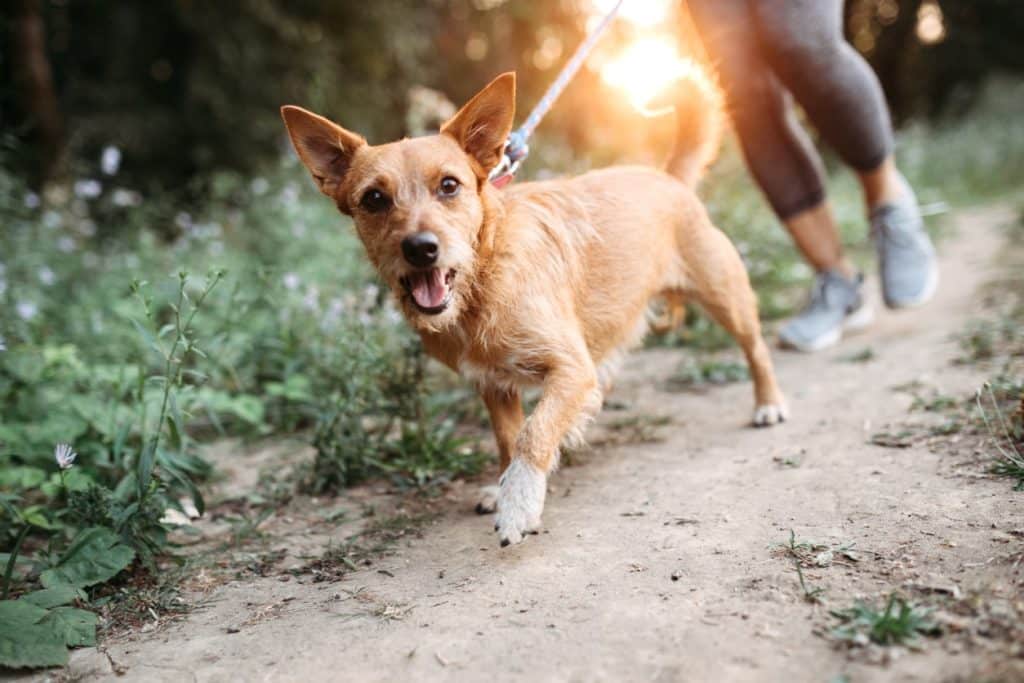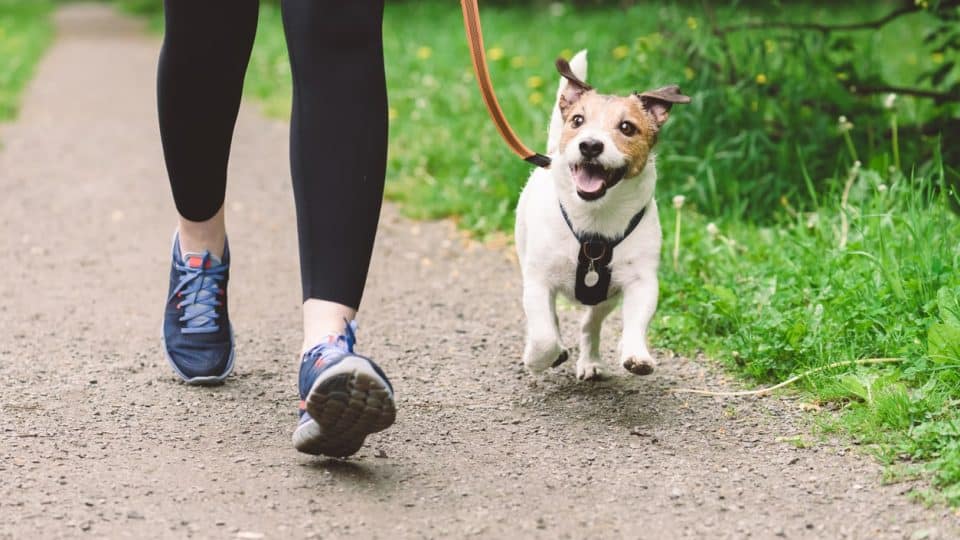Running with your dog is a fantastic way to boost fitness while strengthening your bond. It also provides mental stimulation for your dog, helps reduce stress, and prevents behavioural issues.
“Plus, it’s a great opportunity to explore new places and experience the world together,” points out canine fitness coach Sean Prichard, president of Pant & Wag.
But before you start, it’s crucial to recognise your dog’s limits. With training, some dogs can run for a full hour; others might need to stop after 15 minutes. The key is to build endurance gradually. It’s also wise to consult your vet before starting a new routine.
This guide will explain how to set realistic running goals for your dog. We’ll also cover weather conditions to avoid, strategies for managing distractions like pulling or sniffing, and tips for staying safe and injury-free while enjoying your runs together.
The Benefits of Running With Your Dog
Running is more than just a fun activity for your dog. It also boosts their health and wellbeing. Here are some compelling benefits of running with your dog.
- Improved physical health. Regular exercise keeps your dog at a healthy weight while lowering your own cardiovascular risks. You’ll fight obesity, build endurance, and enjoy longer, healthier lives together.
- Mental stimulation. Running exposes your dog to new sights, sounds, and smells. “This sensory engagement satisfies their natural curiosity and reduces boredom,” explains Webster Cheong, a certified dog trainer and canine fitness instructor at Pet Coach SG.
- Strengthened bond. Running together promotes teamwork and trust. “Dogs thrive when they feel connected to their humans, and running gives you a chance to communicate in a fun, active way,” says Cheong.
- Anxiety relief. A well-exercised dog tends to be calmer and happier, and spending time in nature is equally soothing for humans.
- Training opportunities. Running reinforces skills like impulse control and lead manners. Cheong explains that these skills can improve behaviour in other settings, from vet visits to dining out.
- Socialisation opportunities. Encounters with other dogs, people, and settings can help improve your dog’s comfort in various environments.
- A happier dog. Research shows that dogs also feel a ‘runner’s high’, similar to the euphoric rush humans feel.

iStock/JMichl
Warm-Up: How To Prepare for Your Runs
Teaching your dog to run with you involves several steps. First, you’ll need to assess their readiness—is your dog old enough to run with you? Are they able to? And more importantly, do they even want to?
From there, you’ll build a fitness and training plan, ensure you have the right gear, and decide what type of runs are best for you and your dog.
Is your dog ready to run?
While puppies may be eager to join you on runs, it’s important to wait until they are fully grown. Running too soon can lead to joint damage and long-term issues. Typically, you can start jogging and running with a puppy around one to one-and-a-half years for most breeds and up to two to three years for larger breeds.
In addition to your dog’s age, consider the following:
- Baseline fitness. Your dog should be healthy and active, without weight issues or any heart or respiratory problems, says Annie-Mae Levy, a certified dog trainer at Woofz.
- Training. Before hitting the trail, Prichard says dogs should know some basic cues like heel, sit, and stay. They should also have a solid grasp of loose-lead walking to set a comfortable pace and prevent pulling.
- Socialisation. Prichard emphasises that dogs should be well-socialised so they’re prepared to encounter other dogs, wildlife, and new sights along the trail.
- Interest. Your dog should be eager to join you for a run. Look for enthusiastic body language like an upright wagging tail and perked ears.
If your dog isn’t ready yet, focus on building their fitness and preferred behaviours through short walks, play, and training. Cheong recommends incorporating simple exercises such as sit-to-stand repetitions and balance work to build muscle strength and reduce the risk of injury.
What kind of gear is worth investing in?
You don’t need a lot of equipment to start running with your dog, but investing in a few items can elevate your experience and keep everyone safe.
- Waist lead. A waist lead, also called a hands-free lead, offers a hands-free way to run with your dog, allowing you to move naturally without dropping the line. Built-in bungee cords add stretch and protect you and your dog if they change pace or pull. Just be prepared—this type of gear may take some getting used to.
- Travel bowl or water bottle. Dog water bottles are designed to make hydration simple and convenient on the go. Some are even small and lightweight enough to fit into your pocket!
- Visibility gear. Reflective leads, harnesses, and light-up collars provide more visibility, especially in low-light conditions.
- Weather-proof clothes. If your dog has short fur or you live in a cold region, a fleece jacket provides warmth without overheating. For rainy days, a waterproof rain jacket helps keep your pup comfortable.
- Booties. For dogs who tolerate them, booties offer year-round paw protection. They shield against hot pavement in summer and provide warmth and traction on icy surfaces during winter.
Off-lead vs. on-lead
On-lead running is perfect for folks who want to maintain control. To run on a lead, your dog should feel comfortable beside you, responding reliably to cues like ‘heel’ and ‘slow’.
For those seeking adventure, off-lead running offers a thrilling sense of freedom for dogs. However, it demands a higher level of training. Your dog must have a solid recall, meaning they should return promptly, even around exciting distractions. Good voice control is crucial.
If your dog can’t respond quickly to your cues, they shouldn’t be off-lead (even if they’re friendly). Finally, always ensure the area is safe and legal before allowing your dog to run off-lead.

iStock/RyanJLane
Training Your Dog To Run With You
Just like us, dogs need time to build their stamina. Prichard recommends setting a realistic goal, such as three to five miles, and gradually working toward it. Aim for two to three weekly runs, balancing exercise days with well-deserved recovery days.
As you train, keep a close eye on your dog to watch for signs they’re ready to progress. These include:
- quick recovery post-training
- maintaining a steady pace
- no signs of fatigue
- eager for more
On the other hand, it’s time to slow things down if you notice:
- prolonged recovery time
- limping
- excessive panting or heavy breathing
- paw irritation
Remember, fitness levels vary by individual dog. And some breeds, like Dalmatians and Vizslas, are better dogs to run with than others.
This plan targets a three-mile goal, but training regimens will differ from one dog to another. Always be attentive to your dog’s signals and adjust your training accordingly. You can also repeat weeks if you or your pooch need more time to build endurance.
| Week | Running time | Walking time | Total | Distance Goal |
| Week 1 | 1 minute | 1 minute | 20 minutes | 0.5-1 mile |
| Week 2 | 2 minutes | 2 minutes | 20 minutes | 0.75-1.5 miles |
| Week 3 | 3 minutes | 2 minutes | 20-25 minutes | 1-2 miles |
| Week 4 | 4 minutes | 2 minutes | 25-30 minutes | 1.25-2.5 miles |
| Weeks 5+ | 5 minutes | 2 minutes | 30-40 minutes | 1.5-3+ miles |
Week 1
Levy recommends starting with a mix of walking and running, covering no more than half a mile to a mile in your first sessions.
Start every run with a five-minute walk to warm up your dog’s muscles. Then, alternate between jogging for one minute and walking for one minute. Repeat this cycle 10 times for a total of 20 minutes.
Week 2
Continue to alternate walking and running, but increase the time you spend running. Try to run for two minutes, then walk for two minutes. Repeat this five times.
You’re ready to move on if your dog is enthusiastic and comfortable with the added distance.
Week 3
Run for three minutes and walk for two minutes. Repeat this cycle four to five times. Aim to reach one to two miles total by the end of the week.
Weeks 4
Run for four minutes and walk for two minutes. Repeat this cycle four to five times.
Weeks 5 and beyond
Continue to alternate jogging and walking but gradually increase jogging time (eg five minutes jogging, two minutes walking).
Tips for recovery after each run
As you near the end of your run, slow down with a few minutes of casual walking to help your dog recover and regulate their heart rate. Once home, give your pup water and offer a tasty treat or chew to refuel and reward their effort. A gentle canine massage can also soothe muscles and help dogs relax.
Dos and Don’ts for Running With Your Dog
When running with your dog, prioritise their health, safety, and enjoyment.
What to do
- Start slowly. Just as you wouldn’t leap from the couch to a marathon, your dog needs time to build stamina. Gradually increase distance while checking in on your dog throughout the process.
- Carry water. Bring enough water for both you and your dog and offer regular water breaks.
- Stick to trails. If possible, choose nature trails over concrete to protect your dog’s joints and provide a cooler, shady environment.
- Monitor your dog. Watch for signs of fatigue or discomfort, like heavy panting or lagging behind. Even if your dog wants to keep running, they may need a break.
- Prioritise recovery days. Balance your runs by alternating exercise days with rest days.
What not to do
- Don’t start too young. Avoid running with puppies—they need to finish growing before taking on long distances with you.
- Don’t assume all dogs are runners. Every dog has a unique personality, and not all dogs will love running, even super active ones. Take note of your pet’s enthusiasm (or lack thereof) for running.
- Don’t neglect basic training. Essential cues like sit, stay, and loose-lead walking are crucial for safety.
- Don’t ignore body language. Watch for signs of enjoyment or fatigue. For example, a loose, bouncy body is often a positive sign, while a tense face shows stress, and excessive panting indicates it’s time to slow down.
- Don’t force your dog. Remember, this is your dog’s run, too! If they seem tired or overheated, let them take a break or end the run.
Weather considerations
Running can be a year-round activity—but each season brings unique challenges.
In spring, rising pollen levels can trigger allergies or respiratory issues. Summer brings heat-related concerns, like heatstroke and burnt paw pads. Always watch for signs of overheating, such as excessive panting, drooling, or lethargy. If it’s too hot for you, it’s too hot for your dog.
As autumn arrives, be wary of hazards like slippery leaves or hidden debris that could lead to injuries. And don’t forget the shorter days—reflective gear is essential for those evening runs.
In winter, cold temperatures can lead to hypothermia or frostbite. Avoid salt along pavements and check for ice chunks stuck in your dog’s paws.
Managing pulling, stopping, and lunging
The world is filled with distractions, from squirrels and intriguing smells to fellow joggers. But dogs who constantly stop running to sniff or lunge at distractions can be frustrating and even dangerous.
To help your dog stay focused, Cheong recommends rewarding them with praise, treats, and toys whenever they run calmly by your side. This positive reinforcement will encourage them to stay close and keep the lead slack. Teaching cues like ‘focus’ or ‘steady’ can also help redirect their attention away from distractions, Cheong notes.
If your reactive pup pulls on the lead due to perceived threats, you can work on desensitisation and counter-conditioning outside of runs. Adding management, like opting for routes with fewer triggers, can make runs more enjoyable. Using a shorter lead can also give you more control.
For dogs who consistently pull, it may be time to revisit the fundamentals of loose-lead walking.
How To Avoid Injuries
Running injuries in dogs can range from damaged paw pads and broken nails to chafing caused by ill-fitting harnesses, as well as sprains or muscle strains.
Before embarking on long-distance runs, gradually build stamina—yours and your dog’s! Start with short runs that mix walking and jogging, especially for less fit pups who might push themselves too hard.
High-energy breeds, like Cattle Dogs and Weimaraners, are particularly prone to pushing their limits. For these dogs, you can incorporate cross-training activities like swimming or fetch to keep them fit without leading to overexertion.
Aim to run on soft surfaces like grass instead of hard pavements to minimise joint stress and prevent arthritis down the road. Keep nails trimmed, and consider using booties or a paw wax for added protection.
After each run, inspect your dog’s paw pads and legs for any signs of injury (eg skin damage, swelling, or pain).
What to do when you or your dog can’t run
If you or your dog have physical limitations, there are plenty of enjoyable alternatives to running that still encourage fitness and bonding.
Swimming offers a full-body workout without putting stress on joints. If water isn’t an option, consider gentle hiking on easy trails where you can explore at a comfortable pace. You could even try the relaxing practice of dog yoga or ‘doga’, where you and your pup can stretch and build strength. Scent work is another fantastic option that lets dogs use their natural abilities without physical strain.
Mental stimulation is important, too. Engage your dog’s mind with puzzle toys or teach them new tricks—both are excellent ways to keep their brains active. Don’t forget about interactive play; games like tug-of-war or simple fetch are fun ways to stay active.
Remember, staying fit and engaged doesn’t need to involve running—there’s a world of fun to discover with your pup!



